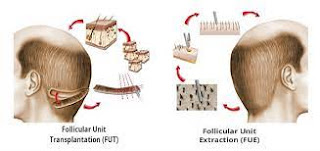Types of Hair transplant
Hair transplant surgery is used to treat men who are suffering from thinning and balding. In most men hair loss or alopecia is caused by dihydrotestosterone or DHT. This is a hormone that causes follicles to thin and eventually fall out. This type of alopecia is commonly seen as male pattern baldness. In those suffering from this condition, postiche is initially lost in the temples and the crown, but the age can progress to include the entire top part of the scalp. However, grafts on the back-end side of the scalp is completely resistant to this alopecia processes so hairs from these regions are surgically transplanted to the new location where the follicles is losing its growth can last a lifetime.
Male
pattern baldness in
doctors’ term is called androgenic alopecia, it is the only type of alopecia
which is very common in men. Over the age of 50, 50% of them are suffering from
this male pattern baldness. Research has found that one cause of male pattern
baldness is the genetics of the patient who is affected by this. The other
factors which cause these problems are like the food we eat. It plays a
principal role in this problem. So be aware of what you eat. The other factor
is stress, we can say that it is directly proportional to the postiche your
loss the more you take stress the more hairs of yours will be lost. Basically, there are two surgical methods one is
follicular unit extraction and the second is strip excision harvesting or we
can say follicular unit strip surgery.
So, let's talk about FUE or follicular
unit excision technique.
Follicular unit excision technique uses a circular surgical punch to cut around
each hair follicle individually; this releases the hair root from surrounding
skin. Each follicle is then lifted up using serious care to protect it.
Incisions are made in the target area of the scalp, controlled for postiche
depth, angulation, direction and density. Each postiche is then reinserted
individually. The whole procedure is performed under local anaesthetic allowing
you to sit back and relax. The area from where the grafts are plugged out heels
with dot-like scars, less than a millimetre in size. Usually, these scars
cannot be seen when the surrounding postiche grows to one or two after
approximately three months the newly implemented postiche will shed before
growing again in four to twelve months. This is when the full hair transplant
result can be seen. Results should last for over 20 years, maybe you can say
for a lifetime. Now it's time to see which
patients can apply for this FUE technique. Patients who do not want long hairs
and want short hairs, those patients who can bear a little bit tight skin, and
patients also have to keep in mind that after surgery a widened scar may
appear. Now, let's talk about the main thing which the patients have on their
minds that is the Cost of an FUE technique. It costs between $4000 to $15000
per session, depending upon how much air is plugged out and transplanted. One
factor also determines how much you have to pay and that is about your surgeon
how experienced or in-demand your surgeon is.
Now it's time to talk about follicular unit strip surgery.
follicular unit strip surgery the surgeon typically removes about 6 –10-inch
strips of your skin in the back side of your head. They then join the two ends
which are opened and sew them. The area is hidden by the curls around it but it
leaves a permanent line on the back side of the patient's head. Next the
surgeon divides the strip which he has extracted from the back side of your
head and divides it into 500 to 2,000 tiny grafts, each containing individual graft
or just a few hairs. The type and number of grafts where you are getting the
transplant depends upon your donor area, quality, colour. The latest technique
for hair
transplant in Lahore Pakistan is FUE like other countries of the world.

